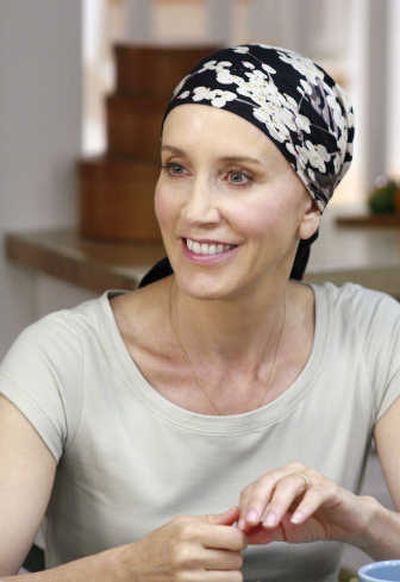C-word, TV rarely collide

“Despite cancer’s grave presence in contemporary life, only a few television series have included it in their plot lines.
Until Lynette Scavo, Felicity Huffman’s character on “Desperate Housewives,” started chemotherapy for lymphoma (with the attendant hair loss and scarves), a major character on network TV hadn’t dealt with the disease since Candice Bergen’s in the final season of “Murphy Brown.”
If cancer occurred at all on TV, it was usually found among members of ensemble casts or the supporting cast.
Kim Cattrall’s saucy Samantha Jones in “Sex and the City” had breast cancer but beat it. Not so lucky was tennis star Dana Fairbanks (Erin Daniels), who died of cancer on “The L Word.”
Further back, Swoosie Kurtz’s Alex went through treatment for breast cancer in the series “Sisters”; Shannen Doherty’s Brenda had a breast-cancer diagnosis on “Beverly Hills, 90210”; and Lacey (Tyne Daly) tangled with the disease on “Cagney & Lacey.” Even Jean Stapleton’s Edith Bunker had a scare.
Still, cancer did not dominate, even on hospital shows, though Alexis Davis on “General Hospital” contracted lung cancer, and George’s dad and possibly Meredith’s mother succumbed to the disease on “Grey’s Anatomy.”
But the instances are relatively few among dramas, considering that about 565,650 Americans are expected to die of cancer this year, according to the American Cancer Society. That’s a rate of more than 1,500 deaths a day. Cancer accounts for one of every four deaths in the U.S. and is second only to heart disease as the country’s leading cause of death, the organization says.
Leroy Sievers, blogging about his own disease on a National Public Radio Web site in a column called My Cancer, noticed while at home with a cold (and undergoing chemotherapy) that none of the shows on the 100 or so channels he surfed through reflected anybody having cancer.
“You can see just about anything on TV these days, but when was the last time you saw a character who just happened to have cancer?” he wrote. “Now I’m not asking for equal time. I don’t think TV characters should be getting cancer by the dozens, but it just doesn’t seem to have a place in our entertainment world.”
But a few shows have emerged on cable in which the central characters not only have cancer, but also have the disease dictate their actions.
“Side Order of Life,” which ran on Lifetime last summer, starred Marisa Coughlan as a magazine photographer who reorders her life when she learns that the life of her best friend (Diana-Maria Riva) will be shortened by cancer.
Also having a shortened life: the series.
Lifetime announced recently that it wouldn’t renew the show, though its average audience of 2 million bested the network’s average prime-time viewership of 1.5 million.
“Although we are not bringing `Side Order of Life’ back for another season, we are extremely proud of the show, particularly its sensitive exploration of the issue of living with cancer,” the network said in a statement. “Lifetime’s commitment to raising awareness about cancer, especially breast cancer, continues and will grow as we begin our 14th year of our award-winning ‘Stop Breast Cancer for Life’ campaign.”
AMC’s “Breaking Bad,” recently halted because of the writers’ strike, is expected back for more episodes in a second season. In it, central figure Walter White, a brilliant science teacher of some promise, takes a distinctly different path after being diagnosed with lung cancer.
Fearing he’s unable to care for the growing family he’s leaving behind (a pregnant wife and teenage son with multiple sclerosis), he decides to go for quick money by using his chemical knowledge to become the best cook of crystal meth in Albuquerque, N.M.
The cancer is sapping the strength of the character played by Bryan Cranston. Chemo has already caused his hair to fall out, so he shaves his head. And yet being confronted with mortality has emboldened him in a way he might have never been before, living with a newfound purpose (that is also clearly illegal).
New episodes ran out last month; the network hasn’t made an announcement about the series’ future.
For Katie Sampson, the central figure of “Terminal City,” the award-winning Canadian series just imported to the Sundance Channel, the diagnosis of breast cancer has caused her to act out initially.
Sampson, as played by Maria del Mar, drinks before breakfast and shoots golf balls into her neighbors’ houses. While at the hospital, she interrupts a doctor’s live reality show to explain her malady, in an interview that causes headlines because she says the F-word and flashes the breast in question.
This disturbs a network executive, who is clearly more concerned with the utterance of the C-word: cancer.
That was his initial reaction, anyway. He comes around to the idea of using this interesting woman as a host. But the scene points out what exactly is verboten on TV these days.